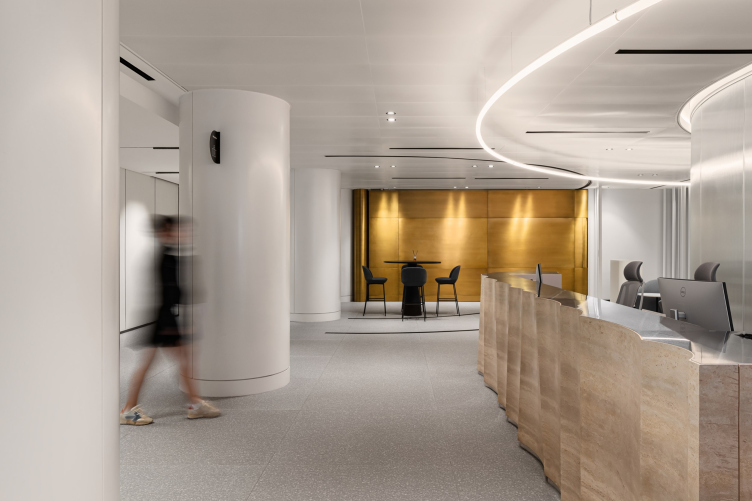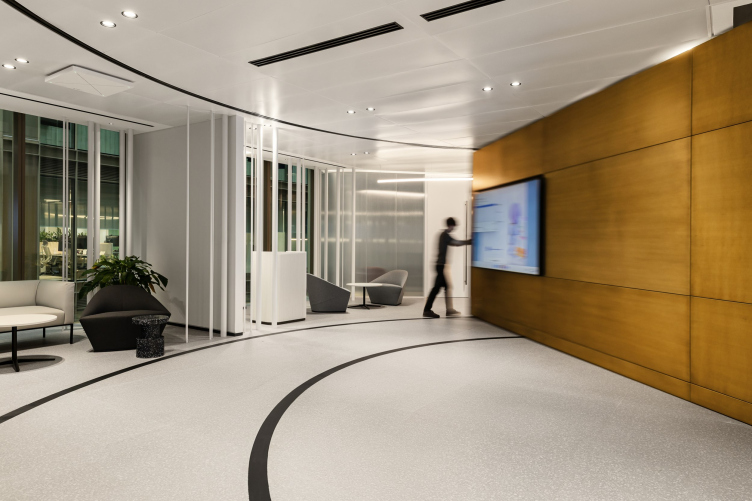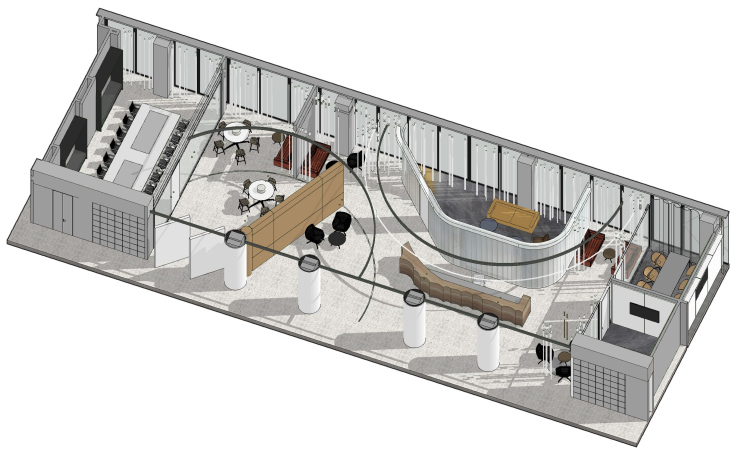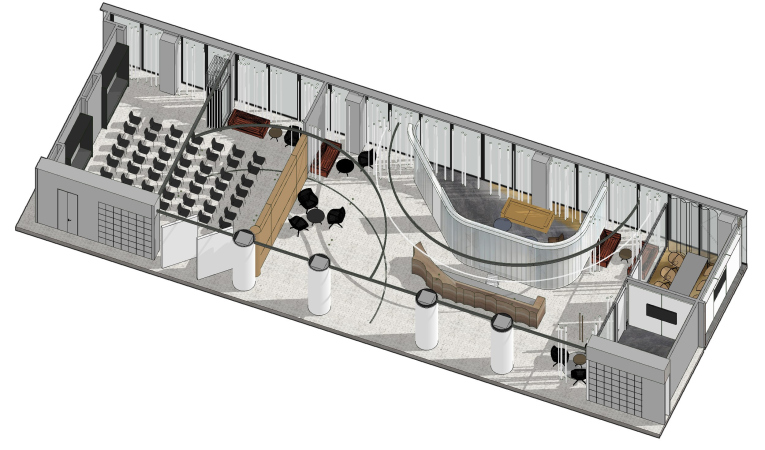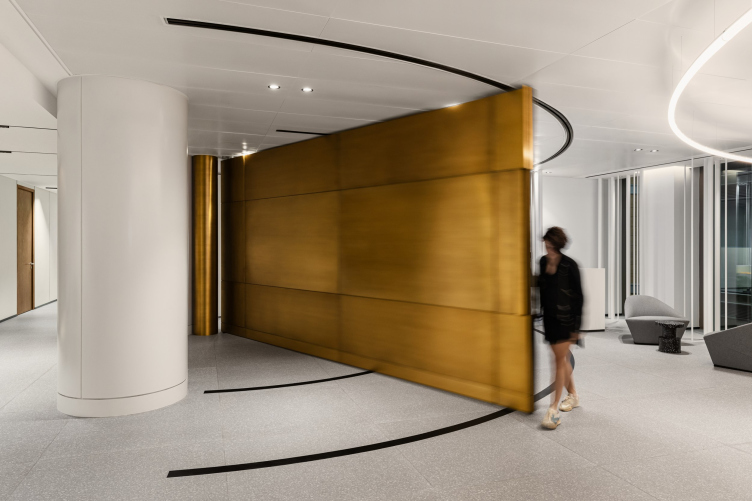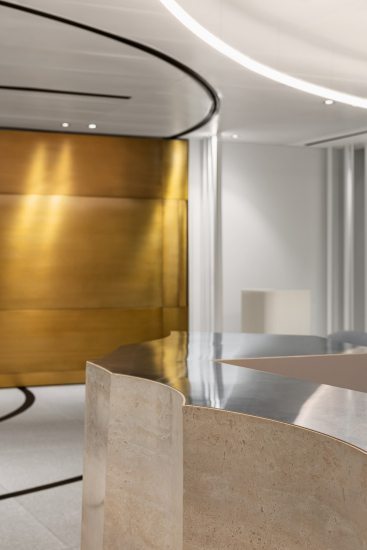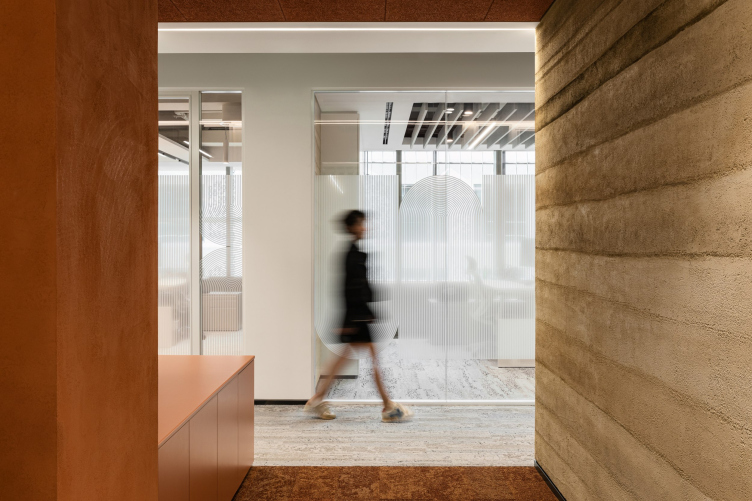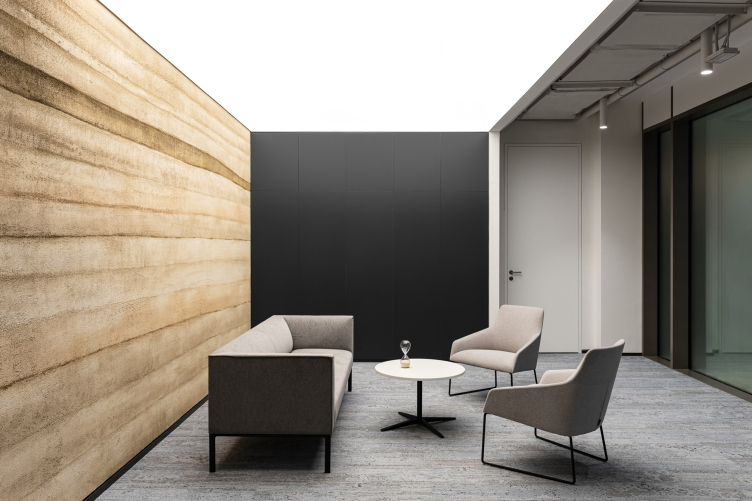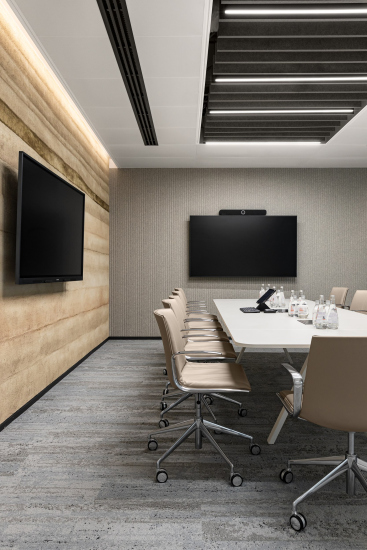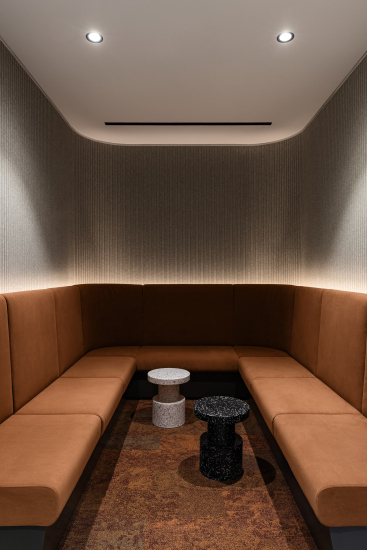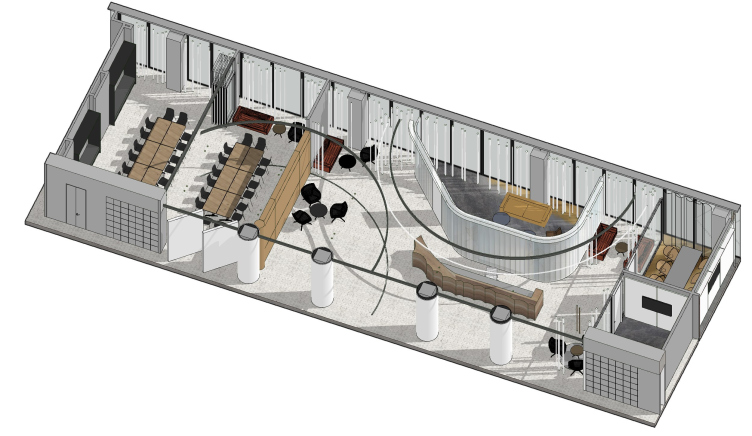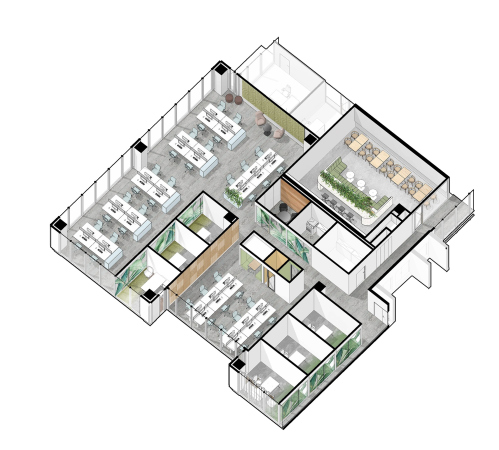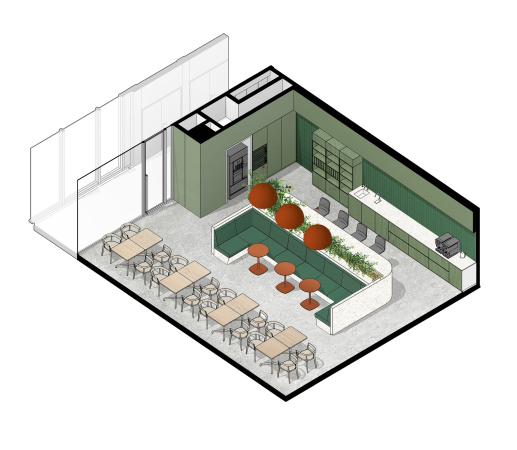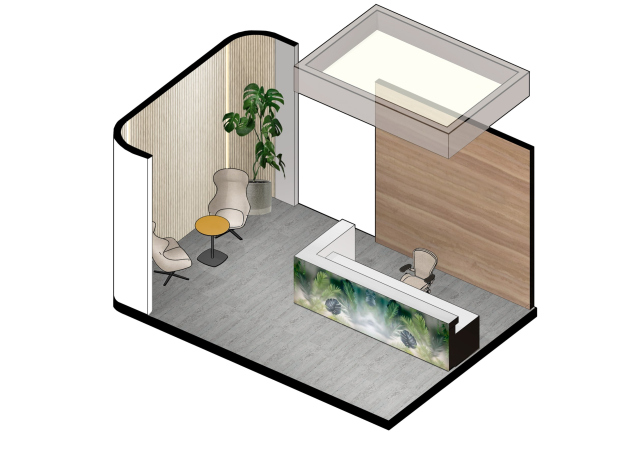Recently, T+T Architects unveiled an office they designed for a transcontinental company specializing in “industrial technologies, innovation, and manufacturing” While the name of the client company and the specific location of the office are kept confidential, the visuals offer insight into the project: the experience that T+T Architects gained through their work on “agile” office spaces in Moscow is clearly integrated here, yet reinterpreted through a series of cultural references unique to Dubai. Also, we can envision the Dubai office setting: a tower with panoramic windows, overlooking a landscape of other high-rises, where, in this case, the office occupies two floors. Dubai’s urban context could be described as globally inclusive – a sort of Middle Eastern New York, where people from diverse cultural backgrounds converge, bringing their own traditions into harmony with the Islamic framework and the challenges of a 40-degree climate. Here, palm trees and birches grow side by side, niqabs and jeans coexist, and mihrabs blend with domes in the skyline.
Thus, beginning the project description with the conceptual design makes perfect sense.
Transcontinental company′s office
Copyright: Photograph © Sergey Nekrasov / provided by Т+Т Architects
Cultural Layers
T+T Architects explore multiple themes, which helps reduce the monotony often associated with office work while simultaneously reflecting the business’s global and multifaceted character in terms of production chains. Energy, in all its forms – from the forces of nature to the sources powering technological processes – served as the primary metaphor and starting point. At the center, however, is the individual, who can harness this energy and use it for good.
The first narrative is defined by the flow of energy and a sense of industrialism. In the interior, this is conveyed through elements that act as a backdrop to more striking accents: light gray floors and walls in a soft milk tone, minimalist “enclosures” for meeting rooms, monochrome matte and glossy furniture surfaces, slim LED strips reflected in polycarbonate partitions, and the graphic lines of ventilation grilles. The architects explain that “the concept is expressed through raw-looking details, mineral hues, and a grainy texture, all underscoring the rugged nature of resource extraction and processing”.
Gold serves as the defining material in the company’s main executive area. Approaching the reception desk, the visitors cannot miss the so-called “golden petal” – a sizable, wall-like “ingot” with a pivoting mechanism that allows for flexible space division. Depending on the position of this structure, the multifunctional hall behind it can transform into a meeting room, conference hall, media center, demo area, or venue for informal gatherings. An integrated digital screen adds further versatility to this multi-feature wall.
Transcontinental company′s office
Copyright: Photograph © Sergey Nekrasov / provided by Т+Т Architects
The six-meter brass-clad partition, despite its apparent “visual” mass, can be easily handled by a single person: its hinged structure with concealed roller mechanisms glides smoothly along rails marked by black lines on the floor and ceiling. While the “petal” creates a wow effect, other gold accents are subtly placed throughout the office – within the lighting of shelves, the mustard tone of planters, the shimmering grain of walls, and the gradient of a “sand-like” carpet.
Transcontinental company′s office
Copyright: Photograph © Sergey Nekrasov / provided by Т+Т Architects
These golden accents represent a second layer of the interior, adding complexity and embodying the culture and natural beauty of the Middle East. One of the architects’ most compelling discoveries in this context is the use of wall panels that mimic compressed earth. This texture is not only visually striking but also rich with meaning: it references a common building technique in the Middle East, symbolizing the passage of time, the earth’s depths, the boundless desert, and the hidden treasures within. Depending on the materials that accompany these panels, they evoke either the sensation of heat from scorched earth or the soft rustling of sand carried around by the wind.
Transcontinental company′s office
Copyright: Photograph © Sergey Nekrasov / provided by Т+Т Architects
Transcontinental company′s office
Copyright: Photograph © Sergey Nekrasov / provided by Т+Т Architects
Working with a variety of materials seems foundational and meaningful in this project. Through these materials, the expression of Eastern identity – conveyed mainly through textures and color choices – feels authentic, drawn from the local landscape rather than relying on stereotypes. The “earthen” walls, contrasts between warm and cool tones, felt light fixtures, subtly ornamented patterns, and carefully positioned focused and diffused lighting all make it clear that this is neither a European nor an Asian space.
Microclimate
Finally, the third layer, which adds depth and vitality to the entire space, is the gardens. In a desert, everyone dreams of the refreshing coolness of trees and vibrant greenery, so all corners of the office are adorned with plant compositions: large pots, planters, stone flower beds, and even the front desk features lush greenery stretching into the distance. Another reference to the plant world is a minimalist “birch grove,” as described by the architects – completely white metal tubes of varying diameters, adorning the central core of the office.
The healthy atmosphere is maintained not only by the greenery. Given Dubai’s extreme climate, the designers paid special attention to dehumidifiers and advanced systems for temperature and air quality control. Finding an aesthetically pleasing way to integrate these extensive utilities proved to be one of the project’s biggest challenges.
Communicating Vessels
As mentioned, the office spans two floors in a modern business center, with areas of 2,470 and 3,790 square meters, respectively. One of these floors is a “representative” level: guests are greeted in a spacious lobby with a striking stone reception desk and the “golden petal” that leads to the multifunctional hall. Executive offices, senior management suites, and meeting rooms are organized around a central core.
Transcontinental company′s office
Copyright: Photograph © Sergey Nekrasov / provided by Т+Т Architects
The second floor offers a wide variety of workspaces to support hybrid business processes: open-plan areas are interspersed with enclosed offices and meeting rooms of various styles, from formal rooms to intimate alcoves with small tables. In addition to the kitchen and dining area, there are also coffee islands that serve as hubs for communication and relaxation. To create a contrasting atmosphere from the work zones, these islands have been turned into design focal points.
For this international project, T+T Architects leveraged experience gained in Russia, where their portfolio includes several completed offices for corporations of the caliber of Sberbank and Gazprom. In Dubai, the architects incorporated a number of these tried-and-true sure-fire solutions. For example, the impressive stone reception desk and the use of textures to reflect the nature of industrial processes can be seen in the office for Gazpromneft Bitumen Materials. The spatial organization, cozy alcoves, and greenery integrated into work zones were honed in the Actyon and MultiSpace Dynamo offices.
The architects, however, also had to contend with local specifics. According to chief architect Polina Voyevodina, the contractors provided the architects with samples and mock-ups for even the smallest details, including hidden profiles and hardware. While this level of precision was appreciated, it made any substitutions nearly impossible after a this or that sample had been approved.
The result is a cohesive and elegant space that subtly conveys identity and makes a statement about its status, while remaining welcoming to both employees and guests: the gold and stone are quite stunning but not overwhelming, and the combination of diverse textures and shades provides an equally strong yet perfectly balanced effect.





